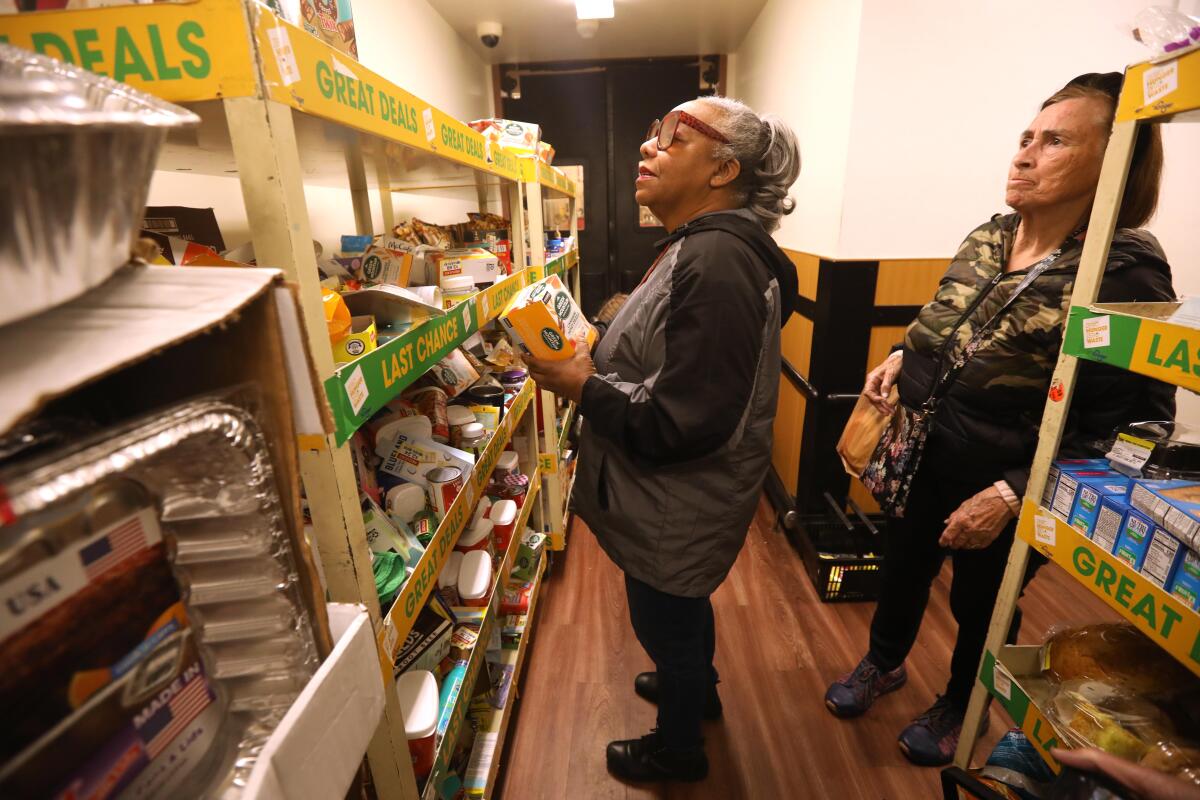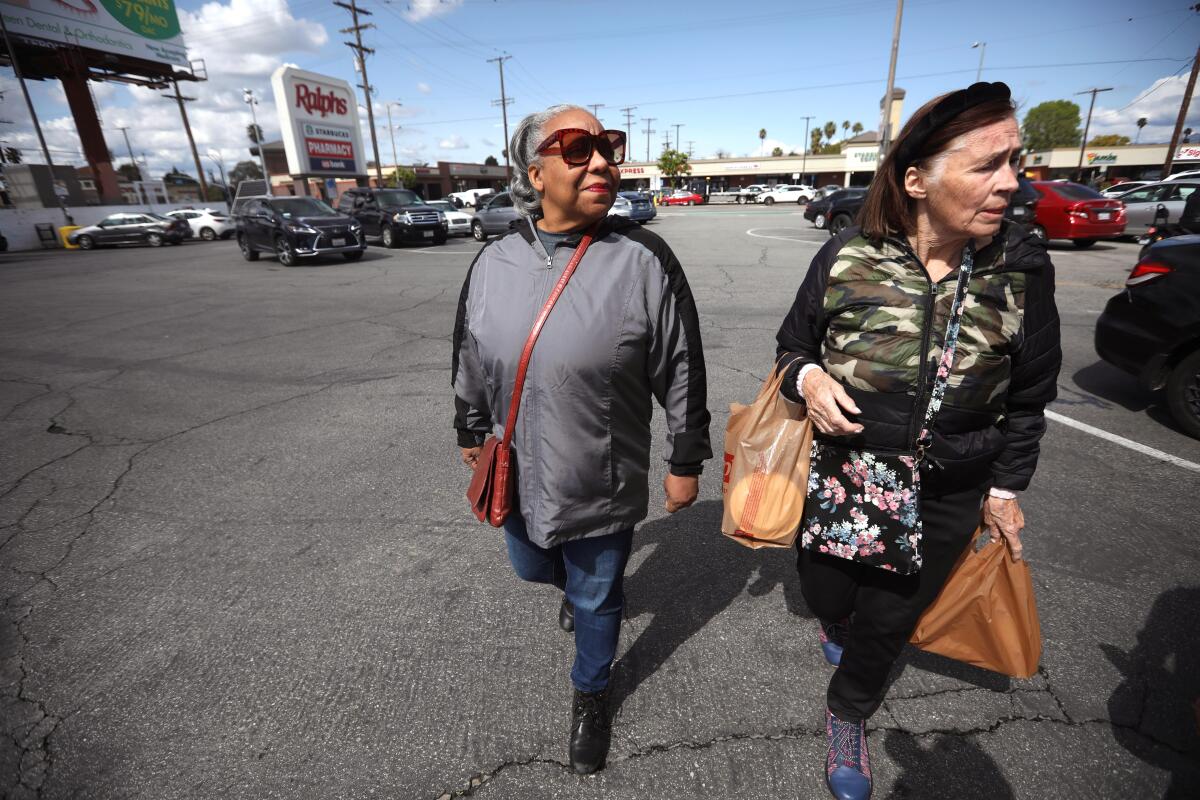Every now and then, Shardreata Moore receives a Subway coupon in the mail and knows she won't have to worry about her next three meals.
“I get a foot long for $7.99 and I ask them to cut it into three,” the retiree told me.
Moore, who was eating lunch at the Sherman Oaks East Valley Senior Center, says he goes to Subway to order a chicken sandwich with whole wheat bread, spinach, cucumbers and tomatoes. That way, he gets some protein and at least some fresh vegetables without having to go to the supermarket, where inflation is deadly.
On a tight budget, Moore said, “it's hard to eat healthy.”
California is about to be hit by a wave of aging populations, and Steve Lopez is taking advantage of it. His column focuses on the blessings and burdens of old age and how some people are challenging the stigma associated with older adults.
Ann Picanza, another retiree, wholeheartedly agreed and was happy to share her cost-cutting strategies, one of which is taking advantage of the daily free lunch at the senior center. On Thursday, the offering was chicken, brown rice, vegetables and fresh fruit.

Shardreata Moore, 67, left, and Ann Picanza, in her 70s, browse bargain shelves at a market in Sherman Oaks.
(Genaro Molina / Los Angeles Times)
When you go shopping, Picanza said, it's not as simple as taking the bus to a store and filling a basket. She bounces from store to store, coupons in hand, searching for bargains as if she were on a scavenger hunt.
“It's hard and I have to buy things I didn't used to buy,” Picanza said. “I used to enjoy buying a piece of meat at the Pavilions, but now, what can you do? I still want meat, so I buy these pies that have meat in them, for $1.49.”
According to AARP, food insecurity among older adults is on the rise and “one in 10 seniors is at risk of going hungry.” He consumer's price index, compiled monthly by the U.S. Bureau of Labor Statistics, indicates some easing of inflation at supermarkets, but still, prices have risen about 25% over the past four years. In January this year, prices for sugar, oil, fruits and vegetables increased slightly, bakery products decreased slightly, and prices for meat, fish, poultry and eggs remained stable.
Even amid signs that inflation is in the declineis a central issue in the presidential campaign, and people on fixed incomes are particularly hard hit by rising utility, housing and food costs.
Of course, when it comes to grocery prices, a president can't just wave a wand at the cash register. Inflation is linked to rising labor costs, continued post-pandemic supply chain disruptions, bird flu, and the impact of extreme weather (heat waves, wildfires, and floods) on global food production.
So prices go up and down, mostly the former, and none of the changes go unnoticed by the seniors I've spoken to over the past few days. At Vons in Eagle Rock, Sylvia Millis and Vernon Bowman grabbed a piece of tri-tip, a cheaper cut of meat, and considered some fresh fruit, looking at the price tags.
“I watch the prices because we have other things to pay for,” said Millis, a retired teacher. “Last month we installed a brand new gas line and the month before that, a brand new water line. You’re not quite sure what’s coming in the future.”
Kris Gaine had a package of ground beef in her cart, with a 30% off sticker.

Shardreata Moore visits a senior center during the week where she can receive free food. “It's tough on the weekend,” Moore says.
(Genaro Molina / Los Angeles Times)
“I buy specials and use a club card,” said Gaine, who is no novice when it comes to collecting coupons. “Oh, I used to be the queen. Remember when they had double coupons?
Gaine said that when he retired several years ago after more than 40 years working in ticket sales and subscriptions at arts venues in downtown Los Angeles, he was financially stable.
“Not now,” he said. “Inflation has exceeded my pension and Social Security. I stand here and shake my head on most of my trips to the grocery store.”
For thousands of low- and moderate-income seniors, food offerings at centers run by Valley InterCommunity Council (VIC) are a lifeline. In partnership with the Los Angeles Department on Aging, free hot, healthy lunches are served Monday through Friday at the Sherman Oaks East Valley location and at the Alicia Broadous-Duncan Multipurpose Senior Center in Pacoima.
VIC also distributes care packages from the Los Angeles Food Bank, delivers to homebound seniors, and connects clients with the state's CalFresh program, which offers monthly stipends for nutritious food at grocery stores.
Beverly Ventriss, president and CEO of VIC, said women who are “aging alone” are particularly affected by inflation. They often outlive their husbands, who take their pensions to the grave. And traditionally, women earned lower salaries than men, so their retirement benefits often don't measure up.
“Basically, I don't buy. It's cheaper for me to eat out,” said Mary Green at the Pacoima center, explaining that she gets meals for as low as $5 with coupons from Burger King, Carl's Jr. and Panda Express. “I live alone and it's cheaper for me not to use the utilities and I don't have to ruin the kitchen.”
She knows it's not the healthiest way to eat, but she receives balanced meals at the senior center. And a tight budget is a tight budget.
“My gas bill is killing me,” said Sara Guerrero, a regular visitor to the Pacoima center. “I had to stop cooking my delicious pork chops. “Now they are too expensive.”
Gail Martin, who worked at the senior center's front desk, told me that two foods keep her alive.
“I eat a lot of cereal, I'm not going to lie,” she said, explaining that brand-name cereal, “not real Cheerios,” has replaced meat at lunch and dinner. “And I eat cups of soup, cups of noodles. “I eat them a lot.”
At the Sherman Oaks center, Moore said she has been hit by a rent increase from $1,190 to $1,400 a month. Since free lunches are served only on weekdays, she doesn't eat three meals on weekends. Picanza said she is handling the mortgage on her condo, but she is affected by the increase in homeowners association fees.
When Moore and Picanza finished lunch, they got into my car and we headed to a nearby Ralphs to see what was on sale. Right through the front door, they went straight to a section of large bins filled with sale items. Ken's Steak House Salad Dressing was reduced from $3.49 to $2.49. Classico pasta sauce is down a dollar, to $1.99 per jar. And Progresso soup, which normally cost $2.79, was $1.79.

Shardreata Moore, left, and Ann Picanza leave the market with some of their bargains.
(Genaro Molina / Los Angeles Times)
“You have to check the dates,” Moore said, examining a can. He also found discounted salmon and ground beef and reminded us that the older it gets, the lower the price.
Savvy shoppers are also watching for what's known as an inflation squeeze, the sneaky trend mentioned by President Biden in his State of the Union address, to keep prices level but skimp on what's in the bag.
In the produce section of the store, Picanza was disappointed because a large bag of refrigerated broccoli she bought for $5.99 had gone up to $6.50.
In another aisle, he picked up a loaf of sliced whole wheat bread, checked the price, and frowned.
“This is not on sale, it's $3.29,” he said. “But it's the bread that I like.”
Picanza said he could ask the manager to write it down.
“She would do it too,” Moore said.
Picanza scanned the store for help. Fighting inflation is not for the meek at heart. The equity gap only increases and you have to pretend you don't know you are living in the strongest economy in the world and keep moving forward.
steve.lopez@latimes.com
The post Column: Cereal for dinner? It's a way to beat inflation in supermarkets appeared first on Telegraph247.